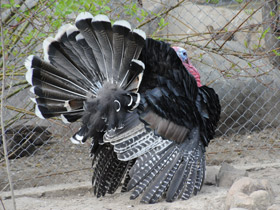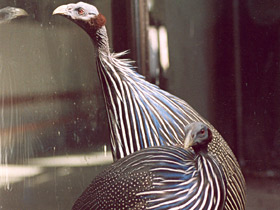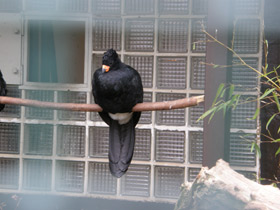Order Gallinaceous (families)
Fowl-like birds Galliformes
The order of Galliformes includes ground-dwelling and arboreal birds sharing some typical features. Galliformes are commonly referred to as “gallinaceous birds”. Gallinaceous birds range broadly in weight from 20-50 g (small quails) to 10-12 kg (turkeys). They have stocky body and small head with a short “chicken-like” beak, strong legs adapted to fast running and burrowing, and wide, blunt, short wings used for swift take offs but not for long flights. All species of this group are mainly herbivorous and have well-developed crops and stomachs, but smaller species, and specifically chicks and young birds, may eat higher percentage of animal foods (mainly insects).
Gallinaceaous birds are mostly polygynous, though in some species males are involved in brood rearing. Polygyneous species can be recognized by their pronounced sexual dimorphism and colouration: males are more than twice larger than females (turkey, Western capercaillie) and have brilliant bright plumage and decorative feathers or skin formations, while females have uniform protective colouration. Many species of Galliformes demonstrate complex courtship behaviour. These birds nest in shallow depressions in the ground, scarcely lined with plant material. Females usually lay 9-12 eggs, but some clutches may consist of up to 27 eggs. Brooding may be absent or conducted by the female. Chicks are precocial; they are covered in thick dark dawn and sometimes have flight feathers. The chicks are able to walk and forage shortly after hatching, but they need to be regularly warmed up by the female during the first two or three weeks of their life. The chicks of galliforms develop fast; downy chicks start flying over short distances before their first moult.
Most Galliformes species are sedentary. Galliforms are found almost worldwide; they are most diverse in the tropics, while birds of Tetraonidae family have adapted to the life at high latitudes. Galliforms present an ancient group that includes species (e.g. megapodes) which, like reptiles, instead of incubating their eggs, store them in mounds or burrows, allowing the heat of the sun to keep them warm. The order comprises at least seven families representing 260 to 280 species (by different taxonomies). Galliforms are important for humans; many of them are traditionally hunted in verious parts of the world; others were ancestors of common fowl, turkey, and guinea fowl. More than 22 species of this order are bred in Europe.














































